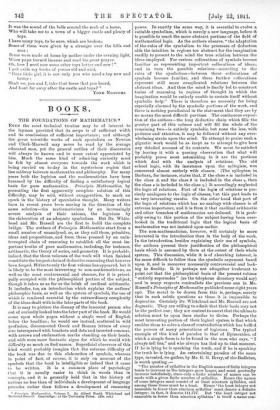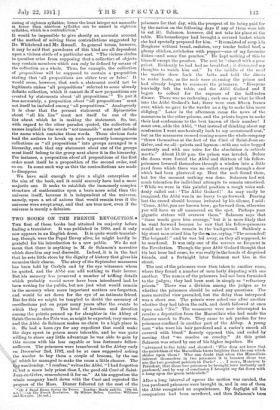BOOKS.
THE FOUNDATIONS OF MATHEMATICS.*
EvRN the most technical treatise may be of interest to the layman provided that it scope is of sufficient width and its conclusions of sufficient importance ; and although the great scientific works of such specialists as Newton and Clerk-Maxwell may never be read by the average educated man, yet the general outline of their discoveries will always be known apd to some extent appreciated by him. Much the same kind of admiring curiosity must be felt by almost everyone towards the work which is being carried on to-day in the mysterious region that lies midway between mathematics and philosophy. For many years both the logician and the mathematician have been harassed by the difficulty of finding a satisfactory logical basis for pure mathematics. Principia Math medico, by presenting the first apparently complete solution of this difficulty, may be said, without exaggeration, to mark an epoch in the history of speculative thought. Many writers have in recent years been moving in the direction of the same solution—the mathematicians by an increasingly severe analysis of their axioms, the logicians by the elaboration of an adequate symbolism. But Dr. White- head and Mr. Russell are the first to build the complete bridge. The authors of Principia Mathematica start from a small number of nnanalysed, or, as they call them, primitive, ideas and propositions, and from these proceed by an unin- terrupted chain of reasoning to establish all the most im- portant truths of pure mathematics, including, for instance, arithmetic, the theory of series, and geometry. It is probable, indeed, that the three volumes of the work will when finished constitute the longest chain of deductive reasoning that has ever been forged. Hitherto only the first volume has appeared, but it is likely to be the most interesting to non-mathematicians, as well as the most controversial and obscure, for it is princi- pally occupied with the philosophical portion of the subject, though it takes us as far as the brink of cardinal arithmetic. It includes, too, an introduction which explains the authors' philosophic basis, as well as the system of symbols, the use of which is rendered essential by the extraordinary complexity of the ideas dealt with in the later parts of the book.
It is easy to picture the dismay of the innocent person who out of curiosity looked into the later part of the book. He would come upon whole pages without a single word of English below the headline ; he would see instead, scattered in wild profusion, disconnected Greek and Roman letters of every size interspersed with brackets and dots and inverted commas, with arrows and exolaniation marks standing on their heads, and with even more fantastic signs for which he would with difficulty so much as find names. Superficial observers of this kind would probably imagine that the extreme difficulty of the book was due to this elaboration of symbols, whereas in point of fact, of course, it is only on account of the symbols that the book is intelligible or indeed that it came to be written. It is a common place of psychology that it is usually easier to think in words than in concepts, and it is generally held that in the history of nations no less than of individuals a development of language precedes rather than follows a development of reasoning
• Principia Mathematica. Volume L By Alfred North Whitehead and Bertrand Russell. Cambridge ; at the 'University Press. Carla net.) power: In exactly the same way., it is essential to evolve a suitable symbolism, which is merely a new language, before it
is possible to reach the more abstract portions of the field of mathematical logic. As the authors observe, "the adaptation of the rules of the symbolism to the processes of deduction aids the intuition in regions too abstract for the imagination readily to present to the mind the true relation between the ideas employed. For various collocations of symbols become familiar as representing important collocations of ideas; and in turn the possible relations—according to the rules of the symbolism—between these • collocations of symbols become familiar, and these further collocations represent still more complicated relations between the abstract ideas. And thus the mind is finally led to construct trains of reasoning in regions of thought in which the imagination would be entirely unable to sustain itself without symbolio help." There is therefore no necessity for being especially alarmed by the symbolic portions of the work, and there is nothing paradoxical in the statement that they are by no means the most difficult portions. The continuous exposi-
tion of the authors—the long deductive chain which fills the greater part of this volume and will fill the whole of the remaining two—is entirely symbolic, but none the less, with patience and attention, it may be followed without any over- whelming strain upon the mind. To attempt to praise such a gigantic work would be as inept as to attempt to give here
any detailed account of its contents. We must be satisfied by leaving it with a passing observation that what will probably prove most astonishing in it are the portions which deal with the analysis of relations. The old school logic, with its insistence upon the syllogism, was concerned almost entirely with classes. (The syllogism in
Barbara, for instance, states that, if the class a is included in the class /3, and the class /3 is included in the class 7, then the class a is included in the class T.) It accordingly neglected the logic of relations. Part of the logic of relations is pre- cisely analogous to the logic of classes, tut this part leads to
no very interesting results. On the other hand that part of the logic of relations which has no analogy with classes is of extreme importance, and it is from it that cardinal arithmetic and other branches of mathematics are deduced. It is prob- ably owing to this portion of the subject having been over- looked in the traditional logic that the logical basis of mathematics was not insisted upon earlier.
The non-mathematician, however, will certainly be more interested in the introduction than in the body' of the work. In the introduction, besides explaining their use of symbols, the authors present their justification of the philosophical basis which is assumed by them at the outset of their whole system. This discussion, while it is of absorbing interest, is far more difficult to fellow than the symbolic argument based upon it, and is moreover necessarily controversial and lack- ing in finality. It is perhaps not altogether irrelevant to
point out that the philosophical basis of the present volume "entirely supersedes" (as the telephone directory would say) and in many respects contradicts the previous one in Mr. Russell's Principles of Mathematics published some eight years
ago. The moral to be drawn from this is, perhaps, merely that in such subtle questions as these it is impossible to dogmatize. Certainly Dr. Whitehead and Mr. Russell are not dogmatic. They are willing to admit that their basis may not be the perfect one ; they a.re content to assert that the ultimate solution must be upon lines similar to theirs. Perhaps the most interesting portion of their logical system is that which enables them to solve a class of contradiction which has baffled the powers of many generations of logicians. The typieal example of this kind of paradox is that of Epimenicles, of which a simple form is to be found in the man who says, " I
always tell lies," and who always has lied up to that moment. If he is lying he is speaking the truth, and if be is speaking the truth he is lying. An entertaining paradox of the same
type, invented, we gather, by Mr. G. G. Berry, of the Bodleian, is worth quoting .--
"The number of syllables in the English names of finite integers tends to increase as the integers grow larger, and must gradually increase indefinitely, since only a finite number of names can be made with a given finite number of syllables. Hence the names of some integers must consist of at least nineteen syllables, and among these there must be a least. Hence the leant integer not nameable in fewer than nineteen syllables' must denote a definite integer; in fact, it denotes 111,777. But 'the least integer not nameable in fewer than nineteen syllables' is itself a name con-
slating of eighteen syllables; hence the least integer not nameable in fewer than nineteen syllables can be named in eighteen syllables, which is a contradiction."
It would be impossible to give ehortly an accurate account of the method of solving these contradictions suggested by Dr. Whitehead and Mr. Russell. In general terms, however, it may be said that paradoxes of this kind are all dependent upon a vicious circle of a particular sort. "The vicious circles in question arise from supposing that a collection of objects may contain members which can only be defined by means of the collection as a whole. Thus, for example, the collection of propositions will be supposed to contain a - proposition stating that all propositions are either true or false.' It would seem, however, that such a statement could not be legitimate unless all propositions' referred to some already definite collection, which it cannot do if new propositions are created by statements about all propositions." To put it less accurately, a proposition about "all propositions" must not itself be included among all propositions." Analogously it is clear that the present statement of Epimenides about "all his lies" must not itself he one of the lies about which he is making the statement. So, too, with regard to the other paradox quoted, the collection of names implied in the words "not nameable" must not include the name which contains those words. These obvious facts lead the authors to break up such apparently homogeneous collections as "all propositions" into groups arranged in a hierarchy, such that any statement about one of the groups must itself belong to the group next above it in the hierarchy. For instance, a proposition about all propositions of the first order must itself be a proposition of the second order, and so on. In some such way as this the contradictions are made to disappear.
We have said enough to give a slight conception of the aim of the book, and it could scarcely have had a more majestic one. It seeks to establish the immensely complex structure of mathematics upon a basis more solid than the universe itself, because it is independent of the universe, namely, upon a set of axioms that would remain true if the universe were swept away, and that are true now, even if the universe is merely a delusion.







































 Previous page
Previous page